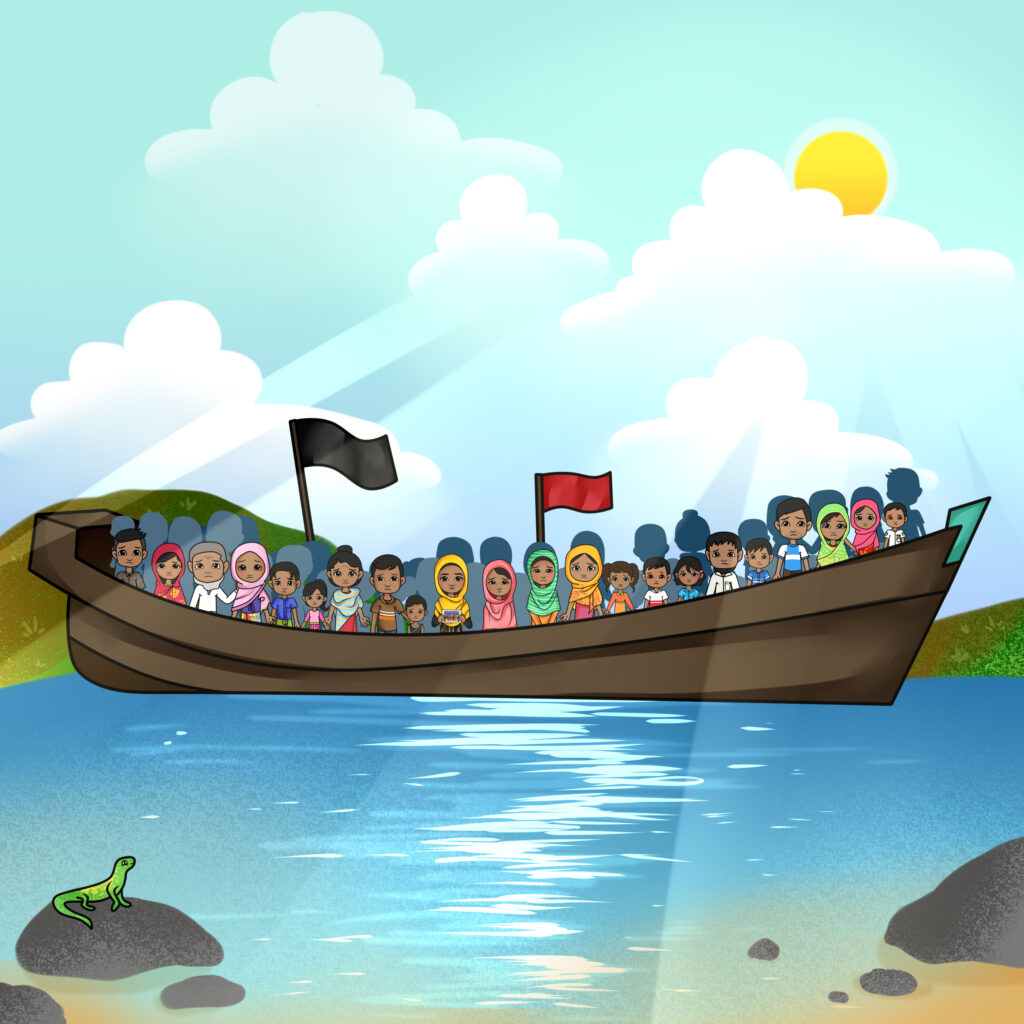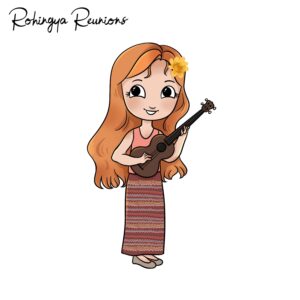Rohingyalish Class
Trauma. A word that carries such weight in its meaning, yet sadly has become far too overused in my generation.
I’m nestled in between a Millennial and GenZ. We use “trauma” to describe the majority of events that made us ever so slightly uncomfortable or stressed. But I think if we dig a bit deeper, we’ll realize that the majority of these events aren’t necessarily traumatic in the true definition of “traumatic” – rather, just an uncomfortable situation that caused stress.
Coming out of high school, I was fairly confident that I knew what trauma was and how it felt. But I was wrong. Nothing could have prepared me for when I came face-to-face with victims of trauma – that’s when I realized how much weight this word truly holds.
Trauma changes you. Physically and mentally.
The moment I saw trauma in its purest and rawest form was when I looked into the eyes of a 5-year-old Rohingya boy.
I was in a room of 15 or so children who were all demanding my attention, but I could not stop staring into the eyes of this boy. His eyes were full of anger, fear, and if you looked long enough – they would become completely blank. As if there was no life to them at all. His eyes had an entire life story to tell at the mere age of 5. It was a story that I didn’t feel I was prepared to know.
He was one of the children who stepped off that bright pink van and entered my school.
That day, everything changed for me.
A bright pink van pulled up to our school in southern Thailand. I was teaching a class when they arrived. I was in class when the pink van arrived, but I peeked out the window to see the bus park right at the office. About 15 children stepped off the bus.
When I was out of class, I went and greeted the children. They were from a nearby shelter that housed temporary refugees. I heard they were from Myanmar, so I greeted them in Burmese. They didn’t respond. I greeted them in Thai. No response. I tried English. No response.
Where were these kids from?
My coworker pulled me aside. “I think they’re Rohingya.”
“Rohingya?” I asked him. Embarrassingly, I had no idea what he was talking about.
“Yeah, you know. From Rakhine State. In Myanmar. Many of them pay traffickers to take them to Malaysia. But a lot of them end up in Thailand instead. The situation is bad in Myanmar right now.”
I had to hold myself back from asking any further questions because I was embarrassed that I had never heard of these people before.
Who are the Rohingya? Where do they come from? These children looked so different from my other students. They were Muslim, not Buddhist. They were slightly darker-skinned. They didn’t speak Burmese. They looked so different from my Karen, Chin, and Kachin students who had come from Myanmar.
They stayed during lunch break and eventually went home on their bright pink van. I went home and took a deep dive into Google search to figure out what in the world “Rohingya” means.
I came across pieces written by Nicholas Kristof (thank you, Nicholas for all the amazing work you do!!) and others about the Rohingya in 2014 – the world’s most persecuted people. How have I never heard about this before?
I learned about their history and the horrific abuses they faced at the hands of the Myanmar military. At this point, sadly, I wasn’t phased by the abuses…many of the people I worked with faced similar hardships. But what I couldn’t get out of my mind was that little boy’s face and the stories his eyes told me.
I had never seen trauma until I looked into the eyes of that little 5-year-old Rohingya boy.
The bright pink van arrived the next morning. I was determined to make more progress than I made yesterday.
I started speaking in English again to the children. Most of them stared at me with blank faces. No smiles. I saw the 5-year-old boy whose face haunted me the night before. It looked the same as before. I tried making funny gestures to make them laugh, but nothing changed. Slightly insulted by the silence in the room after I pulled out my best efforts to make them laugh, I realized maybe it wasn’t a “me” problem.
Eventually…days later…one of the older Rohingya boys, probably a 12-year-old, finally spoke to me IN VERY GOOD ENGLISH! His name was Siphul.
“We come from Myanmar. We are Rohingya.”
“Wow, you speak English! How did you learn?”
“My uncle smuggled English books into our village. That’s how I learned. My father is an Imam. He fled to Malaysia. We took the boat from Myanmar to meet him in Malaysia, but now we are here. I don’t know what to do.”
Over the next few days, we started to talk more. He shared a bit more about how he came to Thailand, but didn’t share much. Lucky for you, I’m writing this blog 8 years later, so I can tell you exactly how they arrived. But it took me about 5 years to figure out the full story. I wrote a children’s book about it. While I can’t share all the details, here is what I can share:

Siphul, along with about 100 other passengers, paid traffickers to take them from Rakhine State, Myanmar, to Kuala Lumpur, Malaysia. Most of them had family members already living in KL who had asked to reunite with them.
It’s safe to say that they had spent around quite some time on this boat. Little food and little fresh water — a few people died.
They were supposed to arrive in Malaysia, but the traffickers dropped them off at a small island in Thailand territory.
They waited for 3 days without food or water, but were eventually rescued by the Thai navy. The Thai navy took the refugees and put the women and children (12 years and under) to a temporary shelter in Phang Nga, and they put the men at a detention center in Ranong, Thailand.
I happened to live 5 minutes away from the Phang Nga shelter.
The more time I spent with Siphul and his friends who would arrive at our school everyday, the more he felt comfortable to share with me. I asked him how I could help him.
“I don’t think we will stay in Thailand forever. We will move to countries that speak English. Really, if you could help us learn English, that would be very good.”
I decided it was probably time to start a separate English class for them…perhaps during my lunch break.
English class with our Rohingya kids…we’ll call it…Rohingyalish class.
Thankfully, I had 2 amazing volunteers from Canada who helped me start this new project. Everyday, during lunch break, we had Rohingyalish class. I looked forward to it every single day. We spent weeks working with these children who have gone through experiences I could never imagine.
And then one day, I finally saw them smile.
It was one of those pivotal moments where I thought, “I think something I’m doing…is working.”
This doesn’t happen a lot, but when it does, it really puts everything into perspective for you.
Flashforward – 80% of these children I met in Thailand are now living in the United States and I have reunited with them, years later.
The story was only just beginning…
